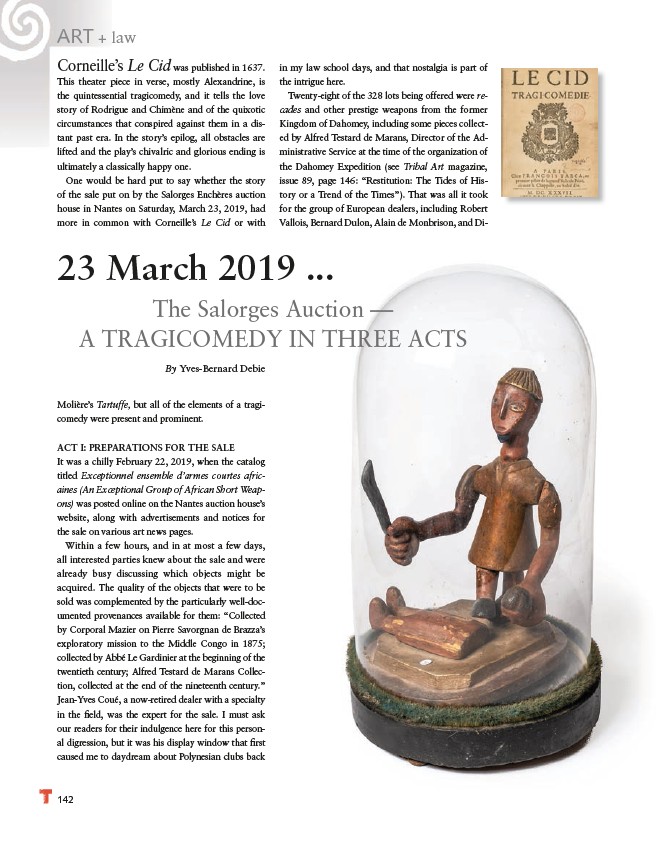
ART + law
Corneille’s Le Cid was published in 1637.
This theater piece in verse, mostly Alexandrine, is
the quintessential tragicomedy, and it tells the love
story of Rodrigue and Chimène and of the quixotic
circumstances that conspired against them in a distant
23 March 2019 ...
142
past era. In the story’s epilog, all obstacles are
lifted and the play’s chivalric and glorious ending is
ultimately a classically happy one.
One would be hard put to say whether the story
of the sale put on by the Salorges Enchères auction
house in Nantes on Saturday, March 23, 2019, had
more in common with Corneille’s Le Cid or with
By Yves-Bernard Debie
Molière’s Tartuffe, but all of the elements of a tragicomedy
were present and prominent.
ACT I: PREPARATIONS FOR THE SALE
It was a chilly February 22, 2019, when the catalog
titled Exceptionnel ensemble d’armes courtes africaines
(An Exceptional Group of African Short Weapons)
was posted online on the Nantes auction house’s
website, along with advertisements and notices for
the sale on various art news pages.
Within a few hours, and in at most a few days,
all interested parties knew about the sale and were
already busy discussing which objects might be
acquired. The quality of the objects that were to be
sold was complemented by the particularly well-documented
provenances available for them: “Collected
by Corporal Mazier on Pierre Savorgnan de Brazza’s
exploratory mission to the Middle Congo in 1875;
collected by Abbé Le Gardinier at the beginning of the
twentieth century; Alfred Testard de Marans Collection,
collected at the end of the nineteenth century.”
Jean-Yves Coué, a now-retired dealer with a specialty
in the fi eld, was the expert for the sale. I must ask
our readers for their indulgence here for this personal
digression, but it was his display window that fi rst
caused me to daydream about Polynesian clubs back
in my law school days, and that nostalgia is part of
the intrigue here.
Twenty-eight of the 328 lots being offered were recades
and other prestige weapons from the former
Kingdom of Dahomey, including some pieces collected
by Alfred Testard de Marans, Director of the Administrative
Service at the time of the organization of
the Dahomey Expedition (see Tribal Art magazine,
issue 89, page 146: “Restitution: The Tides of History
or a Trend of the Times”). That was all it took
for the group of European dealers, including Robert
Vallois, Bernard Dulon, Alain de Monbrison, and Di-
The Salorges Auction —
A TRAGICOMEDY IN THREE ACTS